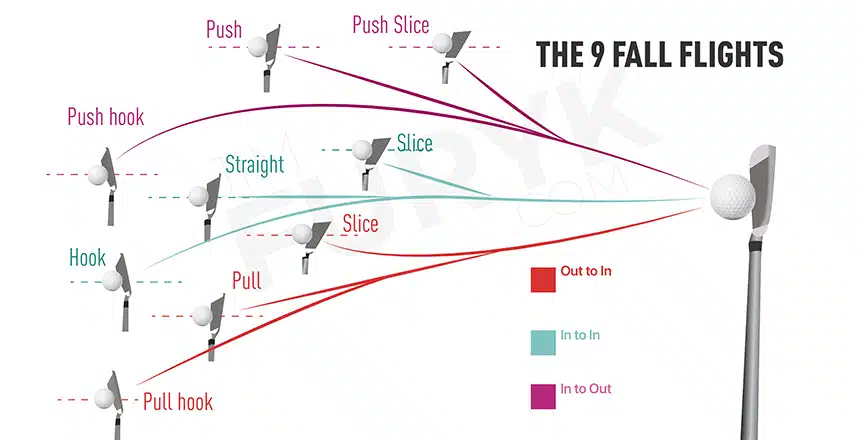Find me a golfer who doesn’t want to improve his/her game!
Most likely, or almost impossible I should say, that you’re not going to come across any single person on that course, a golfing enthusiast or otherwise, who doesn’t want to play better, which means all of us want to understand at least the basics of the sport. And that means understanding ball flight laws!
If your shots, 8 out of 10 times, land up in that same place, then you can and should be able to manipulate or control ball flight. But the first step is to acquaint yourself with the laws, so you can identify the faults in your golf swing. Only then can you achieve greater trajectory and shot-shaping control.
Knowing why the golf ball always flies the way it does, for example slicing your shots, is the first step to fixing that slice or error in ball flight. That said, time to learn all about golf ball flight basics (and to be honest, it’s not all that much either!).
In This Post
All the Different Types of Ball Flight – An Overview
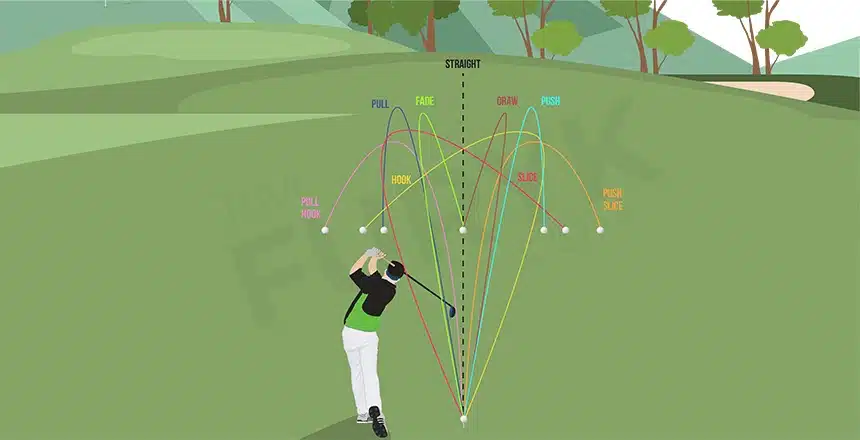
The following basic ball flight paths are for right-handed golfers. So if you’re left-handed, the opposite direction is what applies in your case.
Moving on, there are 6 different kinds of standard ball flights…
Hook and Slice
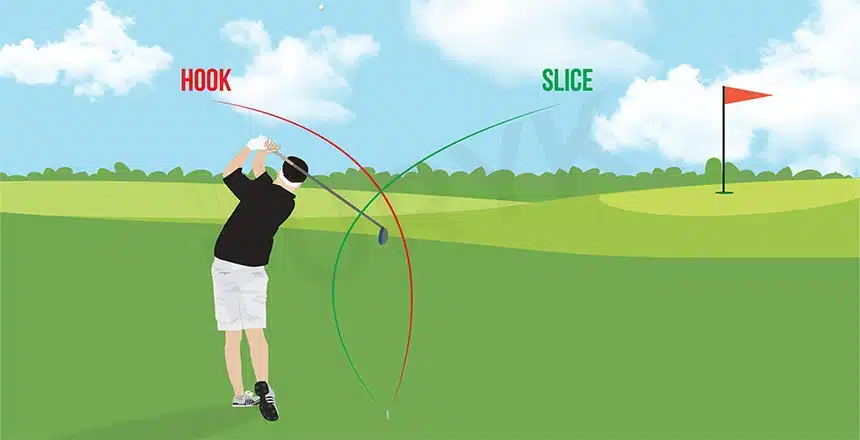
A hook is produced when the clubface is closed at impact, and the flight path the golf ball takes consists of the ball starting from the right and then curving, in flight, to the left.
Once again, this is for right-handed golfers. So for left-hand orientation, hooks will begin from the left and curve to the right.
The opposite of a hook is a sliced shot, which occurs due to an open clubface on impact. So here, the golf ball goes from left to right. The curved ball flight path, in this case, is neither subtle nor is it controlled or planned.
Therefore, you should know how to cure slices if you want to make sure that your golf ball reaches the intended target.
Draw and Fade
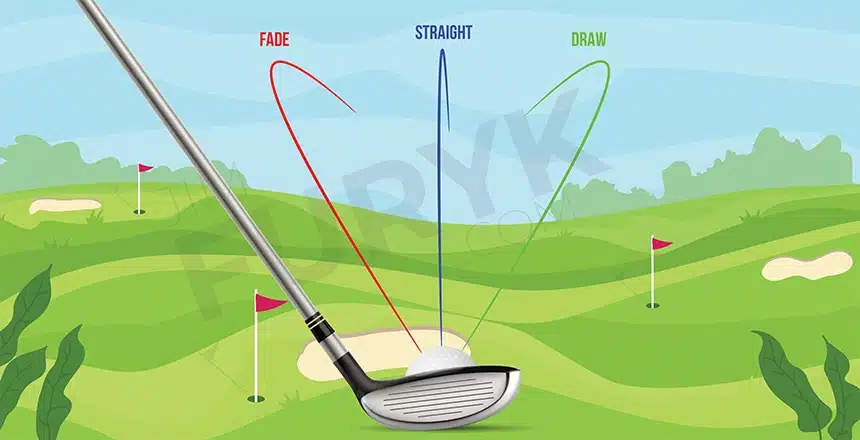
Hooks are right-to-left, while slices are left-to-right. In both cases, the curving of the ball in flight is exaggerated, hence lacking control. On the other hand, draw and fades are slight hooks and slices respectively.
Meaning you can strike a more controlled hook, known as a draw. And that just means knowing how to fix errant hooked shots.
Likewise, fades are a more restrained version of slices. You can purposely hit a fade shot with your driver or irons, for many reasons such as consistency in distance control, softer landing, correcting missed shots, and more. This also involves learning how to fix a fade to avoid having to deal with unfavorable conditions.
Pull and Push
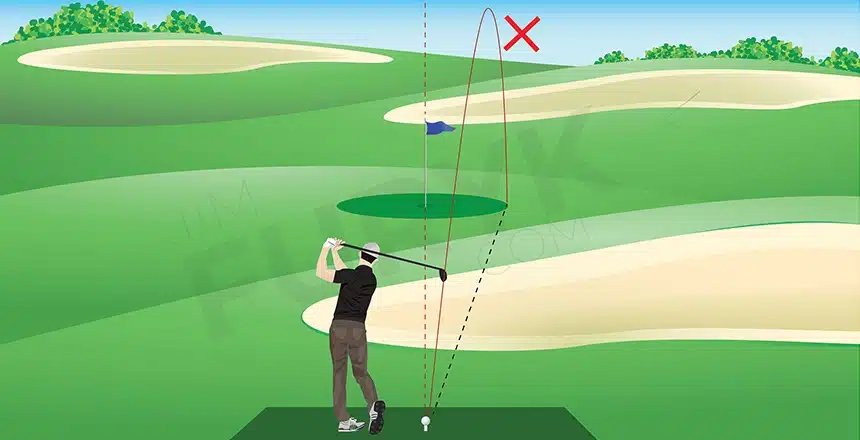
You pull a shot when the ball will start to the left of your target and then fly straight from there. Whereas a push shot begins from the right side instead and then travels straight.
“Pushed” shots you may not be able to completely eliminate, but you can identify their causes to stop pushing your golf shots as much as possible.
The Importance of Ball Flight Laws
Ball flight laws bring to your attention the very cause or causes of hitting draw, slice, push, and pull shots during your round of golf. Otherwise, it becomes very difficult for you to figure out which part of your swing, grip, setup, etc. needs to be corrected or improved.
Let me explain that with a really good and accurate example. You know, precisely because of ball flight laws, that you’re slicing your shots when the trajectory is an extreme, off-the-target curve to the right. Slices are a result of leaving the clubface open through impact, and also because of an out-to-in swing path.
So in order to fix this particular mistake, you have to learn to get the clubface to square at the moment of impact and to also correct your golf swing path.
Factors That Have An Impact on Ball Flight
I’m just going to get straight to the point here. The ball, when flying in the air, is affected by the following…
- Weight – Gravitational forces on the golf ball.
- Drag – The higher the drag, the slower the ball will move in flight.
- Lift – It’s determined by the launch angle of your shot.
Characteristics of Ball Flight
1. Clubface Angle and Path
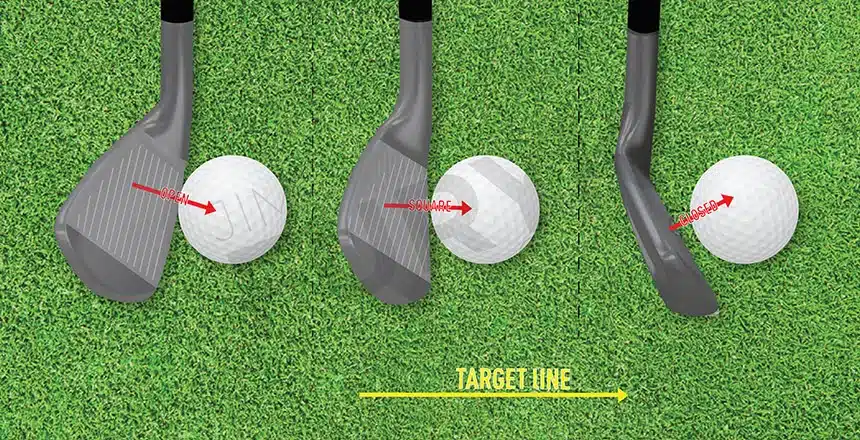
Golf club path simply means the direction your club takes during your swing at impact. Clubface angle indicates the direction your club’s face takes or is aimed at on impact. The latter is responsible for about 75 percent of the initial ball flight, whereas the former affects the starting direction by only 25 percent.
Clubface angle or orientation, no matter what, is the most influential factor when it comes to ball flight. So when this clubface is aimed at the target i.e. square to the target, no curve-producing spin is generated during flight, provided you make center-of-the-clubface contact.
On the contrary, if you leave the clubface open, that means more toward the right of your target path, your shot is then bound to curve more to the right, even when you hit the sweet spot. Much the same way, a closed clubface creates a ball flight that curves toward the left side.
So just keep in mind to get your swing path and the clubface to point in the same direction at impact, which is the direction of your target. But if they don’t, then preventing a curved ball flight is not possible. And the greater the difference between clubface and path, the more the shot curves to the left or right.
Likewise, the lower the loft, the higher the spin toward the left or right. Lastly, the farther you hit, the more the chances of the golf ball curving offline.
2. Center i.e. Sweet Spot Contact
One of the major differences between a Tour player and an average golfer is that the former is able to make solid sweet spot contact. But when hit below, the ball flies lower with more spin. And when hit above the sweet spot, the shot will tend to travel higher with reduced spin.
Along the same vein, hitting more toward the toe region of the clubface gets the golf ball to move right-to-left (draw spin), while hitting more toward the heel produces a left-to-right (fade spin) flight path.
3. Club Loft and Angle of Attack

Clubface angle has a lot to do with the loft angle of your golf club, whereas the angle of attack refers to the path of your club during your swing and on impact.
So there’s a shallow angle of attack and a steep angle of attack, which just refers to the angle the clubhead creates in the form of an ascending or descending arc. Or the attack angle could be neutral as well. And no doubt, the angle of attack or how the club approaches the golf ball affects trajectory.
Lastly, about the angle of attack, let’s make this one thing very clear – no golfer worth his/her salt will hit up on the ball. Look at any Tour pro and you’ll see how he/she strikes their shots by enabling a subtle descending blow. That’s how they get the golf ball to soar higher, straighter, and longer more consistently and accurately.
Moving on to loft angle now, i.e. the clubface angle at impact. The higher the loft, the higher the launch. And by the way, you don’t necessarily have to change your golf club to get a different loft angle. You can just tweak the latter on impact using the same club, which is known as dynamic loft.
If your golf club shaft is leaning more forward through impact, the loft angle of the club will reduce (and vice versa).
Another way to go about it is to change the clubface angle or orientation at impact. When you open the clubface a little more at the time of impact, your shots end up flying higher (this is how you hit cut shots in golf). While keeping the clubface more closed leads to a lower trajectory.
Then there’s the spin loft – the difference between the angle of attack and loft angle.
More spin loft = more spin + less curve + more backspin = straighter ball flight
4. Clubhead Speed and Ball Flight
The greater the clubhead speed, the higher the launch. This increases the spin rate too!
However, please note that the clubhead moving or accelerating really fast can also not affect ball flight. For instance, club A is accelerating and club B is decelerating at the same speed into impact. In that case, both will lead to the same outcome in terms of ball flight.
Nevertheless, also keep in mind that a higher clubhead speed pushes your shots further. And only when this is combined with a good amount of club path and clubface angle control will the flight path stay on target. Otherwise, a golf ball traveling farther can also end up flying farther offline.
Old Ball Flight Laws
These include 3 different types of golf swing patterns at impact.
- Outside-to-inside swing path
- Inside-to-outside swing path
- Square-to-square swing path
Now that’s 50 percent of the effort, the other 50 percent is the clubface angle on impact.
- Open clubface
- Closed clubface
- Square clubface
And now let’s connect the dots based on the old ball flight laws which state that essentially the golf ball starts to fly in the same direction as your swing path and then it curves depending on clubface angle.
- Out-to-in swing path + open clubface = left-to-right curve
- In-to-out swing path + closed clubface = right-to-left curve
- In-to-out swing path + square clubface = (right-to-straight push shot)
Modern Ball Flight Laws
The new ball flight laws do not give importance to your swing path, rather they dictate that the initial direction, at least 75-95 percent of it, is determined by the angle of the clubface at impact. The swing path, however, influences how much your shots curve.
No denying that the modern approach has certainly changed the way we understand ball flight entirely. This could mean not having to work on the swing path any more than is necessary. Instead, you should focus more on being able to adjust or control the clubface on impact.
Wrapping Up…
That’s all there is to know about ball flight. The most important thing is to identify your mistakes. And you can only recognize these errors if you know the basics of ball flight.
The clubface angle through impact can do a lot with regards to controlling the golf ball and how it travels during flight. So I hope this article helped in terms of understanding the difference between wrong and right, and how to go from one to the other!

